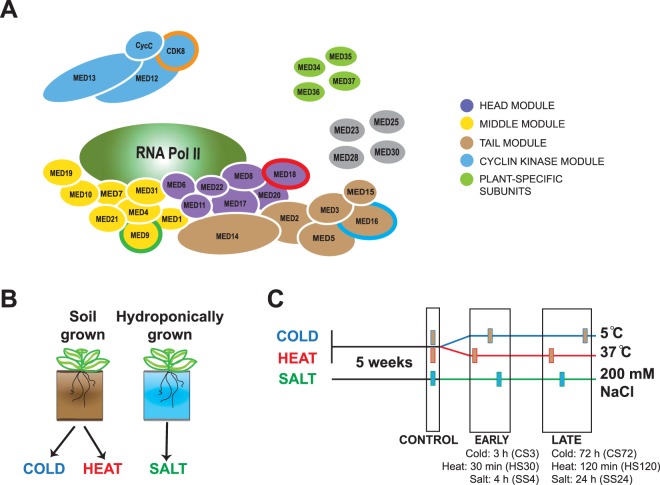Figure 1.
Mediator mutants and abiotic stress conditions investigated in this work. (A) Model of the plant Mediator complex, based on the cryo-EM and crystal structures of yeast and human Mediator and known subunit composition of the purified Arabidopsis complex17,109. Protein subunits within each of the four structural modules are coloured as follows: Head: purple; Middle: yellow; Tail: brown; Cyclin kinase: blue. T-DNA knockouts of the circled subunits (MED9, MED16, MED18 and CDK8) were selected for use in this work. Note that the localisation of the plant-specific subunits (MED34-37) within the complex is unknown, as are the positions of MED23, MED25, MED28 and MED30. In addition, the presence of the MED1 subunit has not been confirmed in the plant Mediator complex. (B) Setup and sampling regime for the abiotic stress experiments. Two separate populations of plants were grown for these experiments, one in soil and one in a hydroponic system as described96. (C) These plants were grown to 5 weeks old in short-day greenhouse conditions, and control samples harvested from each genotype in each population. Plants were then shifted into abiotic stress conditions: either heat (37 °C) or cold stress (5 °C) for the soil-grown plants and salt stress (fresh media supplemented with 200 mM NaCl) for the hydroponic-grown plants. Samples were harvested at an early (30 min heat (HS30), 3 h cold (CS3) or 4 h salt stress (SS4)) or a late time-point of stress exposure (120 min heat (HS120), 72 h cold (CS72) or 24 h salt stress (SS24)). Four independent biological replicates were taken for each sample, where one biological replicate consisted of one rosette leaf each from six individual plants.

